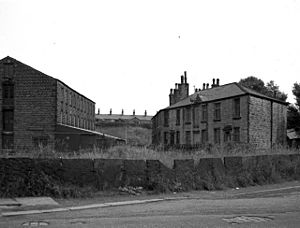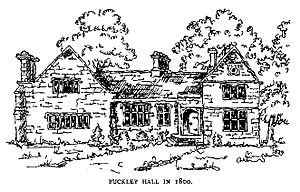Buckley, Greater Manchester facts for kids
Quick facts for kids Buckley |
|
|---|---|
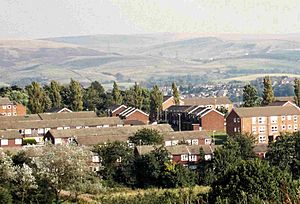 A view over Buckley towards the South Pennines |
|
| OS grid reference | SD906150 |
| • London | 170 mi (270 km) SSE |
| Metropolitan borough |
|
| Metropolitan county | |
| Region | |
| Country | England |
| Sovereign state | United Kingdom |
| Post town | ROCHDALE |
| Postcode district | OL12 |
| Dialling code | 01706 |
| Police | Greater Manchester |
| Fire | Greater Manchester |
| Ambulance | North West |
| EU Parliament | North West England |
| UK Parliament |
|
Buckley is a suburban area found within Rochdale, in Greater Manchester, England. It is located at the northern edge of Rochdale, near a stream called Buckley Brook. The area sits "upon an eminence of ground" close to the South Pennines hills. Buckley is about 1.2 miles (1.9 km) south-southwest of Wardle village and 1.3 miles (2.1 km) north-northeast of Rochdale's town centre. Buckley includes a stream, a prison, farmland, and houses.
Buckley began as a community in the area known as Hundersfield after the Anglo-Saxon settlement of Britain. The name Buckley comes from an old English word. However, the area's history is also linked to a Norman family. This family received the land as a gift after the Norman conquest of England. They then took the name 'de Buckley'. Members of the Buckley family are mentioned in old documents about Buckley and its manor house, Buckley Hall.
For many years, Buckley was the main estate of the township of Wardleworth. The Buckley family of Buckley Hall were important people in the region. They were priests, landowners, and military officers. Over time, their family became smaller due to deaths and people moving away. This led to the Buckley estate becoming less important. As industries grew, the nearby town of Rochdale expanded into Buckley. The area officially became part of the Municipal Borough of Rochdale in the 1870s.
Buckley Hall was used and updated throughout the 1700s and 1800s. But it became empty in the 1880s. A Catholic group called the Brothers of Charity bought Buckley Hall. They turned it into an orphanage for Catholic boys. The orphanage was open from 1888 to 1947. The original building was taken down in the early 1990s. A new prison, HM Prison Buckley Hall, was built in its place.
Contents
History of Buckley
Buckley started as a settlement during the Anglo-Saxon settlement of Britain in the Early Middle Ages. The name Buckley comes from the Old English words æblæc hlæw. This means "bleak hill". Over time, this name changed to "Blakelow," then to "Bucklegh," "Bulkey," "Bukklegh," and "Bucley," before becoming "Buckley."
Early Beginnings and Norman Influence
The medieval hamlet of Buckley was part of the Anglo-Saxon manor of Hundersfield. This was in the parish of Rochdale. Buckley was not well-known until the 11th century. It is believed that Normans who supported William the Conqueror received the estate. This was a reward for their help during the Norman conquest of England. This is how the "ancient" and "local" Buckley family began. This family is the origin of the Buckley surname in North West England.
"Geoffrey de Buckley" is the first known member of this family. He appeared in the 12th century in documents about Stanlow Abbey and Whalley Abbey. These documents also mentioned land exchanges in and around Buckley. Even though Buckley is an Old English name, Geoffrey is an Old French name. The use of 'de' shows the Norman origins of the Buckley family. Geoffrey de Buckley was a church leader. His nephew, also named Geoffrey de Buckley, died in a battle in 1265. He is remembered in church windows.
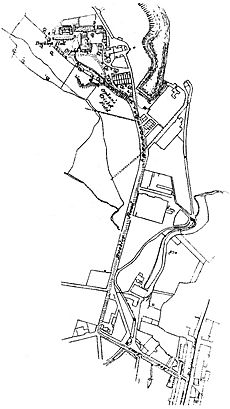
Buckley Hall and Its Owners
At the heart of the Buckley estate was a watermill for grinding grain. This mill existed as early as 1335. Buckley Hall first appears in written records in 1626. It was described as a "faire mansion house." It was owned by families named Buckley, after the area. The Buckleys of Buckley used Buckley Hall as a chapel and a home. They were important in local and regional matters. They served as priests, landowners, and other gentry into the Early Modern Period. For example, Geoffrey Buckley was a Rector in London in the 1470s. John Buckley was a military officer during the English Civil War.
When the manor of Hundersfield was divided into new townships, Buckley Hall became part of Wardleworth. Buckley seemed to be the "principal estate" of Wardleworth. It included land in nearby areas like Foxholes. The main line of the Buckley family continued to own Buckley Hall. Other family members started new families in other towns. The number and influence of the Buckley family slowly decreased. The last member of the main branch was Captain William Buckley.
Growth of Rochdale and Decline of the Estate
The decline of the Buckley family and the growth of Rochdale led to the Buckley estate becoming less important. Buckley Hall passed from Captain William Buckley to his nephew, Thomas Foster. Thomas Foster then took the name Buckley. His son, Edward Buckley, sold the hall and estate in 1786 to Robert Entwisle.
By 1626, a large part of Rochdale was built near Wardleworth. The industrialisation of Rochdale caused it to expand into Buckley. In 1825, part of Wardleworth was included in the area managed by Rochdale's town improvement commissioners. In 1839, an act of parliament allowed Rochdale's Water Works Company to build a reservoir in Buckley. This reservoir would supply water to Rochdale. Buckley Wood Reservoir was finished in December 1841. By 1851, Rochdale had grown far into Wardleworth. In 1872, the rest of Wardleworth became part of the Municipal Borough of Rochdale. This meant Buckley was fully absorbed into Rochdale.
Industrialization and Buckley Hall's New Purpose
The Buckley family was said to be among the first to start the cotton trade in the area. Large-scale textile production came to Buckley with the building of Buckley Mills. Buckley became a "Victorian ensemble" with a mill, workers' homes, and Buckley Hall as the mill owners' house. In 1860, the Schofield family, who were merchants, took over Buckley Hall. Buckley Mills were visited by a Duke in 1873.
Buckley Hall was taken down in the 1860s by the Schofields. They rebuilt it to be very comfortable and grand for its time. It was four storeys high, made of red brick with yellow brick arches. However, in 1882, Buckley Hall became empty after William Schofield died. It stayed empty until 1887, when it was noticed by Herbert Vaughan and the Roman Catholic Diocese of Salford. Buckley Hall was found to be suitable to become an orphanage and school for poor boys. It would be run by the Brothers of Charity, a Catholic group from Belgium. Buckley Hall Orphanage officially opened on March 19, 1888, with 28 Catholic boys living there. Construction of Eclipse Mill at Buckley began in 1899.
Geography of Buckley
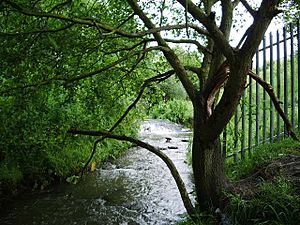
Buckley is located along the northern edge of both Rochdale and the Greater Manchester Urban Area. It sits "upon an eminence of ground" at the base of the South Pennines hills. Its exact location is 53°37′52″N 2°8′31″W / 53.63111°N 2.14194°W. This is about 11.1 miles (17.9 km) north-northeast of Manchester city centre. It is also 170 miles (274 km) north-northwest of central London. The A58 road runs along Buckley's southern edge. The Buckley Brook flows south along Buckley's eastern side. It then joins Hey Brook, which is a smaller stream that flows into the River Roch. Buckley Brook is named because it flows through Buckley.
Buckley has a mix of suburban, semi-rural, and rural areas. It does not have a clear boundary. It is surrounded by other places: Great Howarth to the northeast, Low Hill and Smallbridge to the east, Howarth Cross to the southeast, Fieldhouse and Wardleworth to the south, Cronkeyshaw and Foxholes to the southwest, Nook Farm to the west, Healey to the north east, and Birchin Head and countryside to the north. Foxholes and Fieldhouse have been considered part of Buckley in the past.
 |
Healey | Birchin Head | Great Howarth |  |
| Nook Farm | Low Hill & Smallbridge | |||
| Cronkeyshaw & Foxholes | Fieldhouse & Wardleworth | Howarth Cross |
Governance of Buckley

In the Early Middle Ages, Buckley was part of the Anglo-Saxon manor of Hundersfield. This was within the Rochdale church parish and the hundred of Salford. After the Norman conquest of England, Buckley became owned by the Norman 'de Buckley' family. It was a private estate with land and buildings. In 1576, Buckley was called a "manor". It was still held by the Buckleys of Buckley, but under the control of Sir John Byron, Jr.. When Hundersfield was divided into townships, Buckley became part of Wardleworth township in the county of Lancashire. The Buckley Brook formed Wardleworth's border with another area.
In 1825, after the Buckley family's influence ended, part of Wardleworth was included in the area managed by police commissioners. These commissioners were working to improve the growing town of Rochdale. In 1872, the rest of Wardleworth became part of the Municipal Borough of Rochdale. Buckley then became Rochdale's northeastern border with the Wardle Urban District in 1894. This local government structure continued until after the Local Government Act 1972. In 1974, the County Borough of Rochdale was replaced by the Metropolitan Borough of Rochdale. This is a local government area within Greater Manchester.
Buckley is part of the Rochdale county constituency. This is the area that elects a Member of Parliament (MP) to the UK Parliament.
Landmarks in Buckley
Buckley Hall has been the only major landmark in Buckley. It was first mentioned in a written description from 1626. Even then, it was noted as being an old hall. It held a collection of valuable items until they were sold off in 1884. The Brothers of Charity, a group from the Catholic Church, successfully bought Buckley Hall. They changed it into an orphanage for Catholic boys. The orphanage was open from 1888 until 1947.
To replace older prisons and handle more prisoners, the government of the United Kingdom started using private companies to run prisons. HM Prison Buckley Hall was the fourth privately managed prison in the UK. It was the first private prison for medium-security prisoners. Between 1966 and 1989, it was a detention centre for older teenagers. It reopened in 1994. The original Buckley Hall mansion was then taken down, and new prison buildings were constructed. The current prison buildings opened in 1995. In 2002, HMP Buckley Hall reopened as a prison for female offenders. The first female prisoners arrived in April of that year. Because the number of male prisoners in Britain increased, HMP Buckley Hall became a male prison again in September 2005. Prisoners started arriving in December 2005. In 2009, HMP Buckley Hall could hold up to 381 prisoners.
Public Services in Buckley
Buckley is policed by the Greater Manchester Police force. It is part of the Healey community area in Rochdale North. The closest police station is Rochdale Police Station. Emergency fire and rescue services are provided by the Greater Manchester Fire and Rescue Service. These services come from fire stations in Rochdale and Littleborough.
Hospital services are managed by The Pennine Acute Hospitals NHS Trust. They provide emergency care at Rochdale Infirmary. Mental Health Services are provided by Pennine Care NHS Foundation Trust at Birch Hill Hospital. Community health services, such as doctors, nurses, dentists, and pharmacists, are coordinated by NHS Heywood, Middleton and Rochdale. Waste management is handled by the Greater Manchester Waste Disposal Authority. This is a public authority responsible for waste disposal. Electricity for Buckley is supplied by Electricity North West Ltd. United Utilities manages Buckley's drinking water and wastewater.



